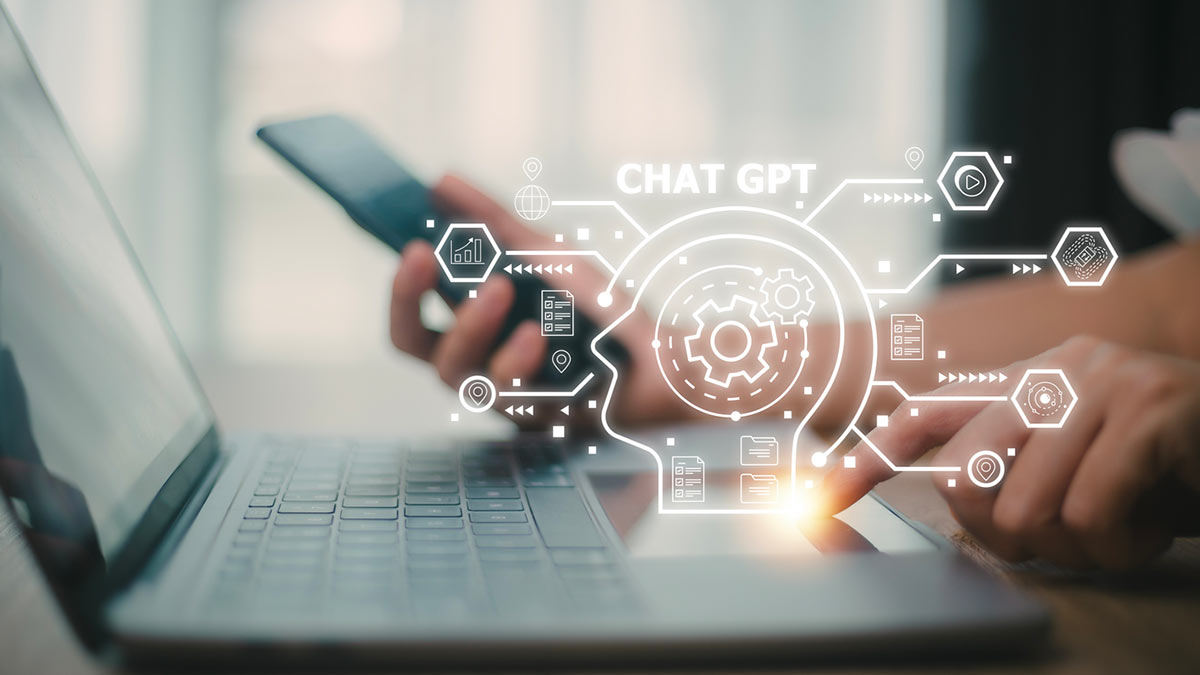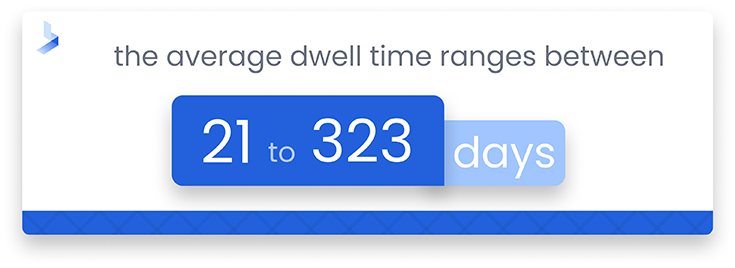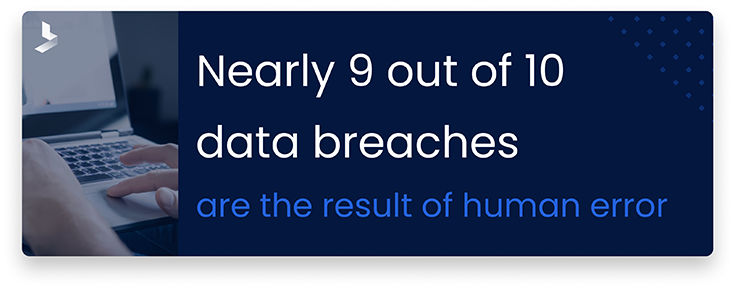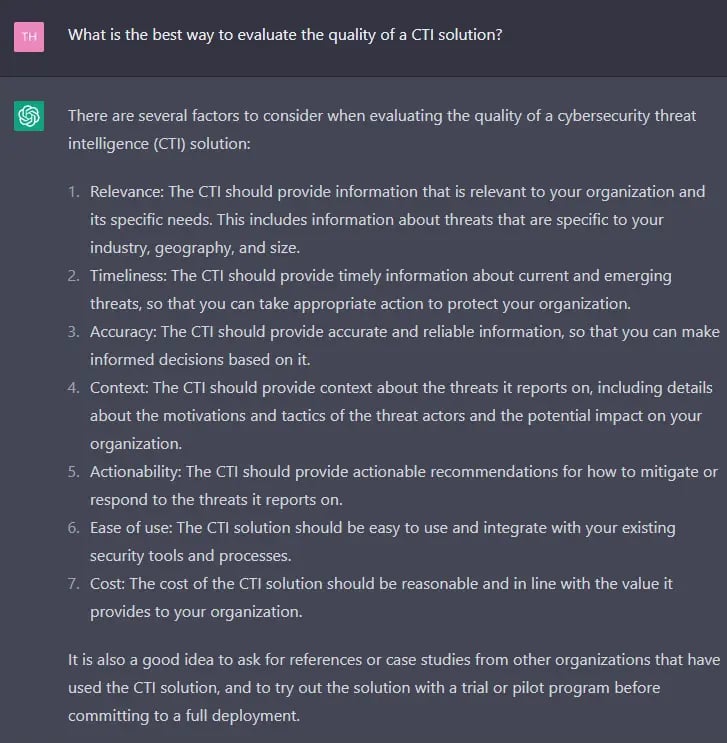Leveraging ChatGPT to Strengthen Your Cybersecurity: Top Strategies

 By
Emily Miller
·
7 minute read
By
Emily Miller
·
7 minute read
If you even have a passing interest in artificial intelligence (AI) and new technology, you've probably heard of ChatGPT. Yet, you may not have considered how the system could help strengthen the cybersecurity posture within your business.
ChatGPT (generative pre-trained transformer) is an AI-powered chatbot created by Open AI and designed to produce human-like text and interact with users in a conversational way. While ChatGPT is technically a chatbot, it is significantly advanced in comparison to any previously released model. Extensive training through reinforcement learning from human feedback (RLHF) makes ChatGPT capable of completing advanced tasks that range from answering follow-up questions to writing an article based on a prompt or even writing and debugging code. The chatbot has even reportedly passed the bar exam with a score in the 90th percentile, and achieved a near-perfect score on the SAT math test.
So, where is ChatGPT's place in the cybersecurity sector? The modern threat landscape is a network of specialized criminals and high-tech tools used to breach network perimeters, access sensitive data, and launch sophisticated and expensive attacks. Would-be hackers with limited technical knowledge can purchase tools and services on the dark web to carry out successful attacks and collect hefty ransoms.
To keep up with the influx of tools and technologies used to carry out massive attacks, cybersecurity professionals need advanced tools to analyze and parse massive amounts of data and detect and respond to threats in real time. ChatGPT's natural language processing (NLP) and deep learning capabilities make the system a powerful tool capable of helping cybersecurity and IT specialists achieve rapid threat detection and response. It can also be used to automate manual tasks and lighten the workload of busy IT and cybersecurity professionals.
Wondering if ChatGTP will make a valuable addition to your security team's arsenal of high-tech tools? This article explores five top techniques for using ChatGPT as a powerful tool to improve your organization's cybersecurity posture.
1. Enhancing Threat Intelligence and Analysis
Chat GPT was trained on massive amounts of data and a diverse range of texts. As a result, the system is able to learn patterns and associations, allowing it to make predictions. ChatGTP's size makes it capable of handling large datasets. The ability to learn patterns means it can analyze patterns in data to identify suspicious behavior and detect anomalies that may indicate a cyberattack. ChatGPT can help analysts create a baseline for normal behavior within a network and then identify unusual behavior. It can also be used to identify and categorize cyber threats, making it easier for analysts to develop a rapid response.
AI tools aren't new in the effort to detect cybersecurity threats in real-time. SIEM and UEBA have long used the same types of technology to effectively recognize suspicious patterns in behavior. ChatGPT brings a different set of abilities to the table by handling large datasets and using conversational language. Analysts can simply ask the chatbot to identify specific anomalies or to group data in an effort to discover new insights. NLP features also mean ChatGPT can analyze text-based communications like emails and chat logs to detect threats. By taking advantage of these advanced abilities, data analysts can improve threat detection with automated responses and assisted threat hunting.
2. Automating Incident Response
Immediate action is essential during incident response. According to various studies, the average dwell time (how long an attacker goes undetected within a network) ranges between 21 – 323 days.
Every action taken by a security team could either expedite the threat or work to remediate it, making each decision a potential dilemma. ChatGPT has the ability to analyze data in real time and offer immediate recommendations. As a result, security teams can respond rapidly with data-backed actions. Since the chatbot's recommendations are based on access to existing data, ChatGPT can offer valuable insights for improved decisions and an overall more effective response.
 During incident response, ChatGPT can step out of the advisory role with automated actions. In SOAR applications, cybersecurity professionals typically spend hours writing specific code to initiate automated responses. ChatGTP can write code for SOAR tools in a fraction of the time, eliminating hours of manual work for cybersecurity professionals.
During incident response, ChatGPT can step out of the advisory role with automated actions. In SOAR applications, cybersecurity professionals typically spend hours writing specific code to initiate automated responses. ChatGTP can write code for SOAR tools in a fraction of the time, eliminating hours of manual work for cybersecurity professionals.
The tool can then be set up to automate repetitive tasks and respond to certain threats without human intervention. It can also be used to quickly and accurately generate incident reports based on data collected during the event. With the ability to pull data from multiple sources, ChatGPT can provide a more comprehensive view of the incident to assist during investigation and pass results on to company leaders and stakeholders. The overall result is a more streamlined and efficient incident response system.
3. Reinforcing Security Awareness Training
ChatGPT can use system training data as well as data collected from your network to generate reports about cybersecurity events. When combined with the system's NLP it can be used to develop highly accurate security awareness training materials. For example, you can direct ChatGPT to describe how a specific type of attack is carried out. The chatbot can even be prompted to create a simulation of a real-life attack scenario. NLP and translation capabilities mean that ChatGPT can be used to write phishing emails that can act as valuable examples during employee training.

Nearly 9 out of 10 data breaches are the result of human error. Many modern cyberattack methods target humans in an effort to get past highly technical automated tools that would otherwise protect a network's perimeter. Every successful cybersecurity solution includes ongoing security awareness training to develop an organizational culture of safety. In today's threat landscape, there are always new threats on the horizon. To keep employees informed, security awareness training must be both engaging and informative. ChatGPT can help produce materials for this level of training.
4. Bolstering Security Policies and Procedures
ChatGPT has access to large quantities of data regarding known threats, threat actor tactics, techniques, and procedures (TTPs), and can be used to collect data from your network. The system's NLP capabilities can also make it efficient in creating documents that follow specific criteria. CISOs can direct ChatGPT to generate policies around a company's specific needs, industry risks, and compliance requirements. If existing policies need to be updated, the original policy can be used as a wireframe to direct the final outcome. As a result, custom and comprehensive documents can be produced with minimal manual effort.
Effective cybersecurity is cultivated through meticulous preparation. A vague plan with a wait-and-see approach is a recipe for failure in today's cybersecurity landscape. An up-to-date cybersecurity policy ensures that all employees and stakeholders are on the same page about how to respond appropriately to threats and active attacks. As new threats emerge, security policies should constantly evolve to keep up with the ever-changing nature of successful cyberattacks. It's an ongoing process that can be difficult to maintain with manual processes.
In some industries, regular cybersecurity policy reviews are mandated by compliance standards. Yet, even businesses not bound by regulations need routine policy updates. All organizations should consider updating cybersecurity policies and procedures when changes take place or a specific amount of time has passed since the last update. For instance, if changes take place in your network (like the introduction of new devices or services or a change in the way employees work) your security policy should be updated to reflect the new adjustments. It's important to note that these updates should be implemented in addition to routine updates. Evolving technology means businesses are always changing. ChatGPT can help eliminate the manual tasks related to policy updates. As a result, organizations are more likely to implement updates in a timely manner to improve overall cybersecurity posture.

5. Streamlining Security Communications
During and after a cyberattack, extensive communications must be carried out across various teams to improve decision-making, launch immediate responses, and improve prevention techniques for the future. Yet, these communications center around complex IT functions and network structures. ChatGPT's natural language processing capabilities come into play again to improve communications between teams throughout the entire cybersecurity process.
ChatGPT can be used in these ways to improve security communications.
- Improving cybersecurity training within your organization: ChatGTP uses natural language and engaging scenarios to provide training materials for employee education. It can also generate convincing attack simulations like phishing emails, and BEC attacks. These simulations can be used as examples or to conduct tests.
- Developing policies and procedures: Cybersecurity policies generated by professionals may include industry terms and jargon that aren't typically used by employees outside the IT team. ChatGPT can be used to generate policies in non-technical language so employees can stay up-to-date on security procedures.
- Outlining cybersecurity threats and solutions to stakeholders: Cybersecurity investments are critical to keeping any organizational network safe from attacks. Yet, communicating these needs during a budget meeting can be challenging. ChatGPT can be prompted to utilize current data for informative presentations and visuals surrounding cybersecurity threats and tools.
- Lowering entry-level requirements for cybersecurity professionals: The talent gap in the cybersecurity industry often leaves teams short-staffed, and therefore, open to vulnerabilities. Yet, training in such a complex industry takes a significant amount of time. ChatGPT's NLP capabilities could serve to lower entry-level requirements for professionals. ChatGTP can write code snippets on command, provide suggestions for incident response, and respond to natural language queries. This could allow junior professionals to fill an important team role without previously required qualifications.
- Enhanced communication between IT professionals and company leaders during an attack: During a cyberattack, every second counts. IT professionals need to be able to share information quickly and efficiently. ChatGTP can generate conversational language, texts, and reports to share easily understandable information in real-time.
- Improved investigation and reporting after an attack: Upon addressing a threat or halting an attack, it's crucial to conduct an investigation to address vulnerabilities and improve your cybersecurity posture. Clarity is critical when reporting the details of an attack, and informing stakeholders about the situation. ChatGPT can be used to collect data for investigation and generate reports using natural language to better communicate findings to non-technical stakeholders. It can even generate relevant visualizations of data, making it easier to identify insights.
Adding a Valuable Tool to Your Security Arsenal
ChatGPT can be used throughout the entire realm of the cybersecurity process to streamline cybersecurity efforts in various ways. It can act as a powerful tool for teaching, sharing information, detecting threats, developing code, automating responses, and generating reports. The chatbot's size and ability to use conversational language make it a stand-out AI tool that is likely to be a precursor to similarly advanced cybersecurity tools.
ChatGPT is not a magical solution that will replace a cybersecurity team. It can't guarantee accurate responses and has been known to confidently provide "hallucinated" information as truth. However, it is a powerful tool that could add significant value to your security arsenal. In fact, Sam Altman, CEO of Open AI, encourages people to use ChatGPT as a tool, not a replacement for human experts. When ChatGPT is used as one of many powerful tools to fight against cybercrime, it can encourage vast improvements to an organization's overall cybersecurity posture.
So, how can you add ChatGPT to your cybersecurity toolbox? ChatGPT 3.5 is available to users as a free service in the research stage. A paid subscription service (ChatGPT Plus) is also available. For $20 a month, ChatGPT Plus provides users with improved access, faster response speeds, and priority access to new features when they become available.
When integrating ChatGPT into your cybersecurity tool lineup, you can get acquainted with the tool one task at a time. Writing and updating policies and procedures is one of the most common ways ChatGPT is used in cybersecurity. Other common uses for ChatGPT in cybersecurity include writing code for SOAR tools and tests to create high-quality phishing emails to improve defenses.
In general, ChatGPT offers the potential to help cybersecurity teams in many ways. However, it isn't a complete cybersecurity solution. If you're unsure about your organization's cybersecurity posture, the experts at BitLyft can help. Get in touch to learn about a comprehensive cybersecurity solution that provides your organization with the power of automated tools along with the expertise of a remote security team.
